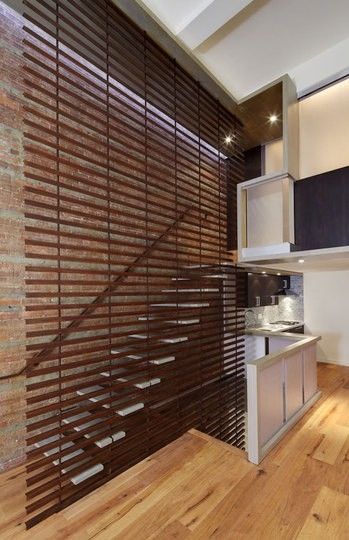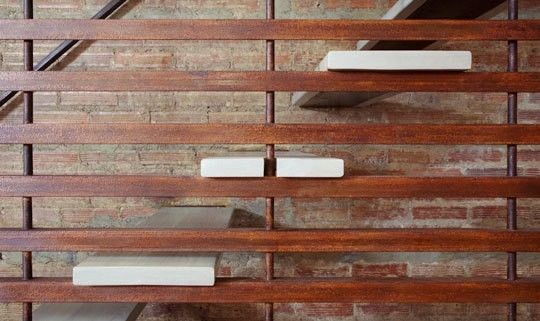Chocolate Patina Steel Staircase




LOCATION: Manhattan, NY
DESIGN: Custom Steel Staircase
This unusual interior renovation is located 2 blocks south of Union Square. The building, originally designed as a warehouse in 1893 by the New York firm of Cleverdon & Putzel, was converted to residential use in 1978. The conversion produced quirky spaces and impractical room arrangements — lofting interior volumes adjacent to small, awkward, isolated spaces. For this reason we sought to transform this odd apartment with a great space into a unified, functional home with great space throughout. This project included a newly relocated kitchen, bedroom, and den, 3 newly expanded bathrooms, and a three storey custom stair.
The owners loved the exposed brick and theatrical space of the living room but were extremely dissatisfied with the closed off kitchen, confused entry, impractical mezzanine, and remote cramped cellar. These problems stemmed from a quick fix 1978 coop conversion. On the first floor, as the apartment footprint is a mere 14' wide and the kitchen is locked between the main entry and dining area, the existing closed kitchen had been too small and blocked both circulation and views into the apartment. In the cellar, the dividing walls, dropped ceilings, and multiple soffits made the exiting space feel claustrophobic, removed, and unlivable. Likewise the existing mezzanine floor area and bathroom were too small to accommodate a bedroom. I thought, only in New York would we find such a beautiful apartment without an adequate space for a single bedroom! To address all of these concerns we removed dividing walls throughout, exposed original ceiling vaults, rearranged storage spaces, relocated the bedroom from cellar to the mezzanine and introduced a new design solution for vertical circulation.
The stair redesign was the key to bridging mezzanine, first floor, and cellar levels and this element is perhaps most interesting aspect of the project. By conceiving of vertical circulation as a three story volume first and as a stair second we sought to create a unified home out of previously isolated experiences. The new stair design simultaneously solves spatial, material, functional, and economical agendas.
Spatially the stair defines a volume that penetrates all three levels, inviting residents and guests to travel from cellar to mezzanine along and around the screen. The screen rises a full 28' height and the chocolate colored acid washed steel is camouflaged against the brick wall. When the space behind the screen is lit the stair transforms into a lantern and light shaft illuminating the living room and cellar. It defines a space which that can be either camouflaged and flat or expansive and volumetric depending on time of day and lighting conditions.
Materially the stair references the antique gazebo, fire escapes, and mottled brickwork of the city and the adjacent courtyard. It also references the resin panels, stained oak, and leather of the interior. Although the stair is a major visual element, by bridging dominant materials from the local environment it blends in to the overall scene rather than standing out and overpowering the space.
Structurally the stair is suspended hung from the ceiling and anchored to the floor. The horizontal angles and vertical rods are calibrated to synchronize with the rise and run of the oak treads. The treads are anchored to the brick wall and on one side and rest directly on the steel angles on the other. Descending to the cellar, the treads and landing are supported by a thin sheet of laser cut steel. The overall effect is that of a suspension bridge — exceptionally light and materially efficient.
